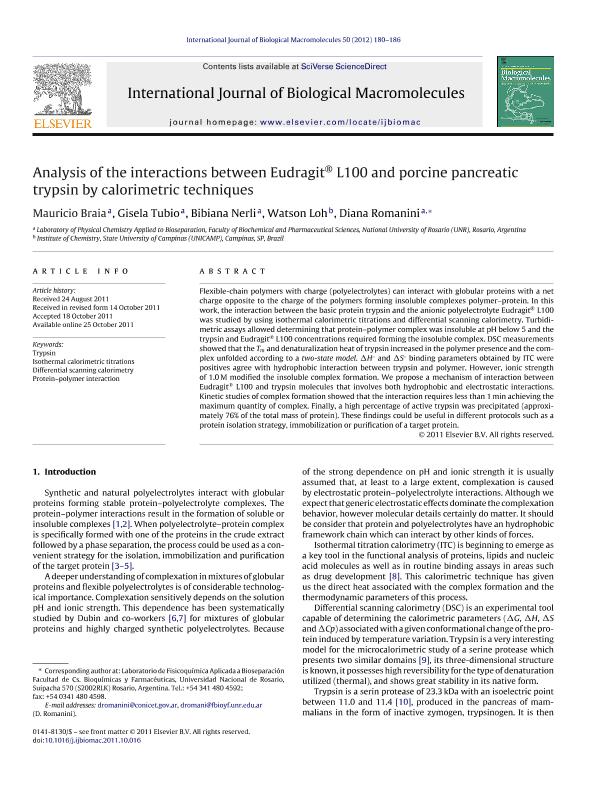Mostrar el registro sencillo del ítem
dc.contributor.author
Braia, Mauricio Javier

dc.contributor.author
Tubio, Gisela

dc.contributor.author
Nerli, Bibiana Beatriz

dc.contributor.author
Loh, Watson
dc.contributor.author
Romanini, Diana

dc.date.available
2023-05-03T19:43:49Z
dc.date.issued
2012-01
dc.identifier.citation
Braia, Mauricio Javier; Tubio, Gisela; Nerli, Bibiana Beatriz; Loh, Watson; Romanini, Diana; Analysis of the interactions between Eudragit® L100 and porcine pancreatic trypsin by calorimetric techniques; Elsevier Science; International Journal of Biological Macromolecules; 50; 1; 1-2012; 180-186
dc.identifier.issn
0141-8130
dc.identifier.uri
http://hdl.handle.net/11336/196175
dc.description.abstract
Flexible-chain polymers with charge (polyelectrolytes) can interact with globular proteins with a net charge opposite to the charge of the polymers forming insoluble complexes polymer?protein. In this work, the interaction between the basic protein trypsin and the anionic polyelectrolyte Eudragit® L100 was studied by using isothermal calorimetric titrations and differential scanning calorimetry. Turbidimetric assays allowed determining that protein?polymer complex was insoluble at pH below 5 and the trypsin and Eudragit® L100 concentrations required forming the insoluble complex. DSC measurements showed that the Tm and denaturalization heat of trypsin increased in the polymer presence and the complex unfolded according to a two-state model. DH y DS binding parameters obtained by ITC were positives agree with hydrophobic interaction between trypsin and polymer. However, ionic strength of 1.0 M modified the insoluble complex formation. We propose a mechanism of interaction between Eudragit® L100 and trypsin molecules that involves both hydrophobic and electrostatic interactions. Kinetic studies of complex formation showed that the interaction requires less than 1 min achieving the maximum quantity of complex. Finally, a high percentage of active trypsin was precipitated (approximately 76% of the total mass of protein). These findings could be useful in different protocols such as a protein isolation strategy, immobilization or purification of a target protein.
dc.format
application/pdf
dc.language.iso
eng
dc.publisher
Elsevier Science

dc.rights
info:eu-repo/semantics/openAccess
dc.rights.uri
https://creativecommons.org/licenses/by-nc-sa/2.5/ar/
dc.subject
DIFFERENTIAL SCANNING CALORIMETRY
dc.subject
ISOTHERMAL CALORIMETRIC TITRATIONS
dc.subject
PROTEIN-POLYMER INTERACTION
dc.subject
TRYPSIN
dc.subject.classification
Físico-Química, Ciencia de los Polímeros, Electroquímica

dc.subject.classification
Ciencias Químicas

dc.subject.classification
CIENCIAS NATURALES Y EXACTAS

dc.title
Analysis of the interactions between Eudragit® L100 and porcine pancreatic trypsin by calorimetric techniques
dc.type
info:eu-repo/semantics/article
dc.type
info:ar-repo/semantics/artículo
dc.type
info:eu-repo/semantics/publishedVersion
dc.date.updated
2023-04-18T13:17:23Z
dc.journal.volume
50
dc.journal.number
1
dc.journal.pagination
180-186
dc.journal.pais
Países Bajos

dc.journal.ciudad
Amsterdam
dc.description.fil
Fil: Braia, Mauricio Javier. Consejo Nacional de Investigaciones Científicas y Técnicas. Centro Científico Tecnológico Conicet - Rosario; Argentina. Universidad Nacional de Rosario; Argentina
dc.description.fil
Fil: Tubio, Gisela. Consejo Nacional de Investigaciones Científicas y Técnicas. Centro Científico Tecnológico Conicet - Rosario; Argentina. Universidad Nacional de Rosario; Argentina
dc.description.fil
Fil: Nerli, Bibiana Beatriz. Consejo Nacional de Investigaciones Científicas y Técnicas. Centro Científico Tecnológico Conicet - Rosario; Argentina. Universidad Nacional de Rosario; Argentina
dc.description.fil
Fil: Loh, Watson. Universidade Estadual de Campinas; Brasil
dc.description.fil
Fil: Romanini, Diana. Universidad Nacional de Rosario; Argentina. Consejo Nacional de Investigaciones Científicas y Técnicas. Centro Científico Tecnológico Conicet - Rosario; Argentina
dc.journal.title
International Journal of Biological Macromolecules

dc.relation.alternativeid
info:eu-repo/semantics/altIdentifier/url/https://www.sciencedirect.com/science/article/pii/S0141813011004065
dc.relation.alternativeid
info:eu-repo/semantics/altIdentifier/doi/http://dx.doi.org/10.1016/j.ijbiomac.2011.10.016
Archivos asociados
